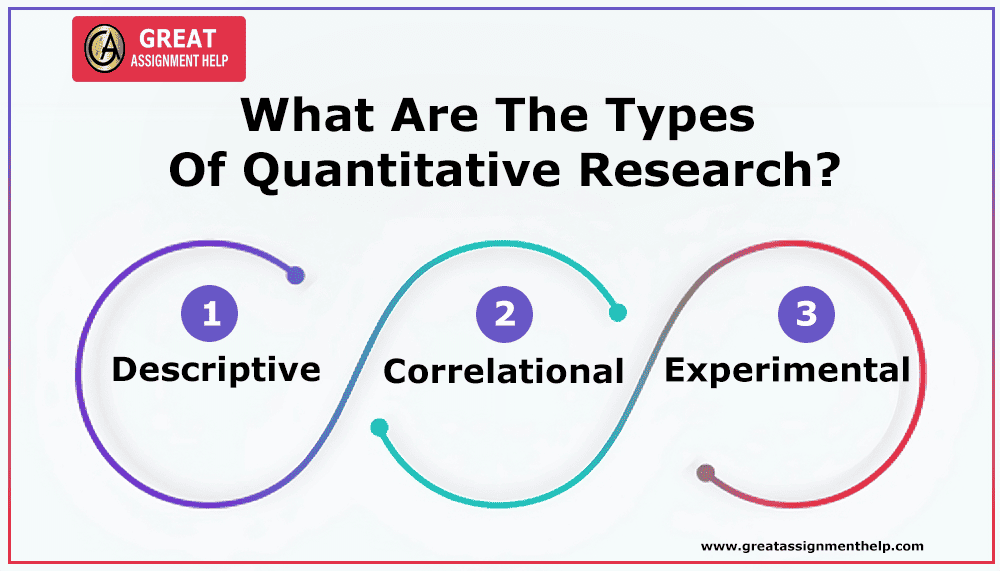Students who are novices to academic research are often unaware of the type of research that can help them find evidence to develop their research papers. Quantitative research is one of them. If you are one of these researchers, you might wonder, “What is quantitative research?” or “What type of data can you find out through quantitative research?” In simple terms, quantitative research is a method that aims to collect and examine data. It uses a deductive approach to emphasize testing theories based on empiricist and positivist philosophies to validate or test them. However, there are various approaches or types of quantitative research. To choose the most suitable research approach, you must also know all the available quantitative research methods. If you are new to these concepts and are curious to learn more, read this blog. Here we have offered comprehensive detail on all aspects of quantitative research. Read along to learn more.
What is Quantitative Research?
Quantitative research involves gathering and examining numerical data to explain, forecast, and manage the variables of interest. You can use quantitative research to explore the following:
- Test the fundamental associations between variables.
- Make predictions
- Simplify results to make them understandable for wider populations.
The primary objective of quantitative research is to investigate pre-defined theories or hypotheses and, in the end, accept or reject these presumed theories depending on their results. However, there is a condition for using quantitative research. You must perform quantitative research, where you need to understand the study patterns by studying the data sets over some time. Typically, quantitative research is used in the following academic fields:
- Psychology
- Economics
- Sociology
- Marketing
Different Types of Quantitative Research
Quantitative research aims to identify the relationship between the independent and dependent variables of your study. It is designed in any of the 3 following forms:
- Descriptive: This feature allows you to find the overall details of the parameters of your study.
- Correlational: With the help of this characteristic of quantitative research, you can determine the connection between the attributes of your study.
- Experimental: This feature allows you to examine whether there is a cause-and-effect relationship between multiple variables in your research.
Prominent Features of Quantitative Research
Quantitative research has the following characteristics:
- Collection of data through structured data instruments
- Results are determined by the sample size that represents the group.
- This research offers objective answers to clearly defined questions.
- All components of the study are carefully considered before data is accumulated.
- You can get quantitative research data in the form of numbers and statistics. They are presented in the form of tables, charts, figures, or other non-textual structures.
- A project can be used to generalize concepts more widely, predict future results, or investigate causal relationships.
- Researchers collect numerical data through tools like questionnaires or computer software.
The quantitative research study aims to categorize attributes, calculate them, and develop statistical models to detail the things observed.
Also read: Inspiring Social Work Research Topics for Students
Points to Remember When Developing Quantitative Research Results
When you develop a report after conducting quantitative research, take care of the following points:
- Explain the data collected: Discuss the treatment of the statistical data and all pertinent results concerning your investigated research problem. The analysis of the results is not relevant in this section.
- Unexpected events: Report unexpected events that took place while you were collecting data. Explain its impact on the actual analyses and how it varies from the intended analysis. Give details on how you handle the missing data and ensure that it does not weaken the soundness of your research.
- Data cleaning technique: Clarify the method you used to polish your data set.
- Choice of statistical procedure: Select a reasonably adequate statistical method. Give a justification for its employment and a reference for it. Detail any computer programs used.
- State the assumptions: Illustrate the hypothesis for each course of action and the steps you took to make sure that your assumptions were not debased.
- Give statistical details: When you use inferential statistics, present the descriptive statistics, confidence intervals, and model sizes for each component, the significance of the test statistic, its trend, and the level of freedom.
- Avoid taking your supposition causally: When you conduct quantitative research through a disconnected or separated design, don’t take your supposition casually without additional testing.
- Use tables to offer precise values: Take the help of statistics to convey global impacts. Use precise records and present them through graphical representation at significant intervals whenever possible.
Various Kinds of Quantitative Research Methods
You can divide quantitative research methods into 4 primary types. It includes:
Experiment
This method involves studying both independent and dependent variables. Here, you must regulate the independent variables to examine their effect on the dependents.
Survey
Here, you provide questionnaires to a group of people by meeting them in person, through phone calls, email, or social media.
Methodical observation
This method recognizes the mannerism or growth of interest and observes it in its natural surroundings.
Systematic research
To conduct secondary research, you gather data that is primarily collected for other studies.
Also read: Computer Science Research Topics
Basic Design For Quantitative Research
The design of your quantitative research varies with the type of study you conduct. Typically, quantitative research design is based on two types of research:
Quantitative research
The following are the conventions of quantitative research:
- Measure the subjects once.
- The aim is to establish a link between the variables.
Experimental research
An experimental design must adhere to the following rules:
- Measurement of variables before and after a specific treatment
- Careful and purposeful choice of a small sample population
- Intended to institute connections between variables
Fundamental Design For Quantitative Research
Here is a typical design for quantitative research:
Introduction
When you write the introduction to quantitative research, write it in the present tense from a third-person perspective. Make sure it covers the following information:
- Recognize the research problem- You must clearly and succinctly discuss the research problem.
- Review the literature- Review your research on the topic. Blend primary themes and, if required, note all the research that has employed similar research methods of investigation and analysis. Find the fundamental gaps that exist in the research field and how your research facilitates filling these gaps or elucidating existing knowledge.
- Describe the theoretical framework – Select the theory or hypothesis to reinforce your research. If required, describe unusual or composite terms, perceptions, or ideas and offer the fitting background information to position the research problem in an appropriate context.
Also read: Excellent Economics Research Topics for Students
Methodology
Write the research methodology in the past tense, discussing the way you will achieve each research goal. Moreover, be sure to offer sufficient detail to help a reader make an informed evaluation of the research problem-finding methods. Ensure to include the following details.
- Learn about population and sampling– The origin of the data, its robustness, the precise existence of gaps, etc. Mention the methods used for data selection.
- Data collection– Explain the tools and methods used to gather data and recognize the variables being calculated. Elucidate the techniques used to collect the data. Also, state whether you have collected the data or if it was pre-existing. For self-collected data, elucidate the type of instrument used and the reason for using the specific instruments. Additionally, talk about the limitations of data collection methods.
- Data analysis– Describe the methods for refining and examining the data. If suitable, describe the exact instruments of investigation used to study each research objective. It may include mathematical methods and the kind of computer software used to control the data.
Results
Write the findings of your study impartially and in a concise and accurate format. In quantitative studies, it is usual to employ graphs, tables, charts, and other non-textual components to help the reader recognize the data. Ensure that non-textual components are included in the text. Moreover, use it to complement the typical representation of the results and to help elucidate key points made in the research.
Statistical analysis: It presents the results in the past tense. Discuss how you examined the data. What were the primary findings from the information? Present the findings in a rational, sequential order. Explain, but do not deduce these movements. Save that for the discussion section.
Discussion
Present the discussion in the past tense. Make analytic, logical, and comprehensive discussions. The discussion should bond together your findings concerning those recognized in the literature review. You must also position it within the theoretical framework that supports the study.
- Interpretation of results– Restate the research problem being studied and compare and contrast the result with the research questions fundamental to the study. Did they confirm the predicted results, or did the data disprove them?
- Narrate the trends, group comparison, or connection between variables – Explain any trends that appear from your examination and give details of all unforeseen and statistically irrelevant findings.
- Discussion of implications – What do your results mean? Emphasize the primary findings of your research developed on the comprehensive results and mention findings that you think are important. Discuss the importance of your research results in filling the gaps in your study and in recognizing the research problem.
- Limitations– Highlight any restrictions or inevitable bias in your research and, if required, state why these restrictions did not restrain the successful interpretation of the results.
Also read: Outstanding Business Research Topics and Ideas
Conclusion
End your study by summing up the research topic and offering a final remark and evaluation of the study.
- Summary of findings– Respond to your research questions. Never report any statistical information here; just offer a descriptive summary of the primary findings and narrate what was found out that you were not aware of before performing the research.
- Recommendations– If appropriate to the objective of your academic paper, link key findings with policy advice or proceedings to be put into practice.
- Future research– note the requirement for future studies related to your study’s limitations or to any existing gaps in the literature that you have not addressed in the study.
Wrapping Up
Quantitative research is a planned method of collecting and examining data from a range of sources. Its aim is conclusive. It is because this research aims to enumerate the issues and recognize their scope, searching for results that can be presented to a larger population.
Researchers use quantitative research to measure scalability and seek neutrally explained statistical results. So data collection through quantitative research helps define the approved cause-and-effect relationship between the research problem and the features.
If you need help for conducting quantitative research, connect with our research paper helpers. The experts of our research paper help service are available round the clock for comprehensive assistance and can help you develop premium quality research papers in no time. Just fill out the student assistance form and submit it. Our experts will take care of all the other requirements.



